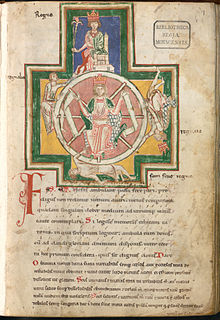Fortuna (mythology)
| Fortuna | |
|---|---|
| Goddess of chance, luck and fate | |

Fortuna governs the circle of the four stages of life, the Wheel of Fortune, in a manuscript of Carmina Burana
|
|
| Abode | Rome |
| Symbol | Globe, Cornucopia, Wheel, Wreath |
| Greek equivalent | Tyche |
Fortuna (Latin: Fortūna, equivalent to the Greek goddess Tyche) was the goddess of fortune and personification of luck in Roman religion. She might bring good or bad luck: she could be represented as veiled and blind, as in modern depictions of Lady Justice, and came to represent life's capriciousness. She was also a goddess of fate: as Atrox Fortuna, she claimed the young lives of the princeps Augustus' grandsons Gaius and Lucius, prospective heirs to the Empire.
Her father was said to be Jupiter and like him, she could also be bountiful (Copia). As Annonaria she protected grain supplies. June 11 was sacred to her: on June 24 she was given cult at the festival of Fors Fortuna.
Fortuna's Roman cult was variously attributed to Servius Tullius – whose exceptional good fortune suggested their sexual intimacy – and to Ancus Marcius. The two earliest temples mentioned in Roman Calendars were outside the city, on the right bank of the Tiber (in Italian Trastevere). The first temple dedicated to Fortuna was attributed to the Etruscan Servius Tullius, while the second is known to have been built in 293 BC as the fulfilment of a Roman promise made during later Etruscan wars The date of dedication of her temples was 24 June, or Midsummer’s Day, when celebrants from Rome annually floated to the temples downstream from the city. After undisclosed rituals they then rowed back, garlanded and inebriated. Also Fortuna had a temple at the Forum Boarium. Here Fortuna was twinned with the cult of Mater Matuta (the goddesses shared a festival on 11 June), and the paired temples have been revealed in the excavation beside the church of Sant'Omobono: the cults are indeed archaic in date. Fortuna Primigenia of Praeneste was adopted by Romans at the end of 3rd century BC in an important cult of Fortuna Publica Populi Romani (the Official Good Luck of the Roman People) on the Quirinalis outside the Porta Collina. No temple at Rome, however, rivalled the magnificence of the Praenestine sanctuary.
...
Wikipedia
